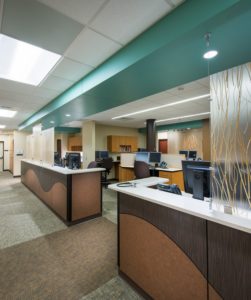When it comes to traditional healthcare, patients are conditioned to a general routine for medical appointments. After checking in and flipping through a magazine in the waiting room, the consultation is followed by time-consuming, non-medical related processes that range from navigating insurance issues to scheduling additional appointments and filling prescriptions.
With the increasing trend of clinics transitioning to a patient-centric model of care, this setup is no longer the norm, due in part to an emerging space called the central care team area. The concept of this clinical hub is to co-locate information, services and resources into one location and provide a highly efficient model of care by using the space in a manner that generates revenue, improves productivity and patient satisfaction.

To successfully support a clinic’s transition to a new model of care, the central care team space design is a key factor to maximize efficient use of the clinic space. This space is an open area strategically located at the center of the clinic module where all staff is co-located. This includes physicians, medical assistants, nursing staff and tertiary care members such as social workers and dieticians.
The idea of this open layout can raise concerns regarding patient privacy, which can be resolved with design techniques such as clear glass panels, lower soffits and applied acoustic treatments. These allow for staff interaction while protecting patient privacy by containing sound within the work unit, while also allowing team members to productively interact with and assist patients. Another design consideration to maintain privacy within the central care team is tall countertops that hide technology from patient view.
Implementation of an efficiently designed care team allows clinics to use the space available to enhance process optimization. Co-locating services and team members will open up space in other areas of the clinic, allowing them to be transformed into exam rooms (revenue-generating space for the clinic).
With a more efficient work system and design allowing medical clinics to better serve more patients daily, the clinic can also reduce the amount of space needed for waiting rooms (as a space that does not generate revenue). Implementing self check-in kiosks also reduces waiting time for patients and further improves HIPAA issues.
In many clinics, the traditional setup may allow physicians to treat about 8-12 patients each day due to inefficiencies in staff flow. With a modern and efficient design, this number could increase to about 20-24 patients. While patient demand may not increase at rural clinics, being able to schedule more appointments on a single day allows the space to be used for alternate revenue-generating purposes on other days.
Another major benefit of this central care team space is how it naturally supports collaboration among the internal care team members by gathering staff into one central hub. This differs from a traditional clinic, where team members are spread out in offices and stations throughout the facility. For example, when medical assistants need information, they do not need to spend time and resources tracking down doctors who, in the traditional setup, could be difficult to find as they spent their days between their offices and exam rooms, and elsewhere within the clinic. Integrating team members into one area optimizes how the clinic interacts with patients/customers, creating patient-centric care.
Care integration adds another layer of transparency to clinics, which is becoming increasingly valued among patients. Patients are able to directly see the care team and its efficient work system, rather than having the care team stationed behind closed doors. As well, the care team is able to improve patient safety by having all exam room doors, as well as the facility’s entry and exit points, within the line of sight.
Productivity is another benefit of the care team. In the traditional clinic setup, many team members work in private offices. By co-locating them in the care team, all activity is visible and time not devoted to clinic work is more easily noticed. Further, the central care team area also plays a key role in recruitment. The facility design supports the patient-centric model of care, and a majority of providers are recruited directly from medical school where this patient-centric model is becoming the standard of care.
As the shift to a patient-centric model continues, the healthcare field is likely to see the central care team area become a more commonplace structure within medical clinics and other modalities. This area will prove to be a key element to maintaining the efficiencies and benefits of this newer model of care that aims to improve the overall patient experience.





